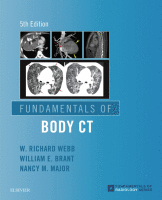Physical Address
304 North Cardinal St.
Dorchester Center, MA 02124

In this chapter entities such as disk disease and the osseous structures of the spinal canal will be discussed again, as well as postoperative spine changes. The appearances of the bones in the setting of some systemic diseases are additional…

Introduction The advent of increasing numbers of rows of detectors has expanded the utility for CT technology. Multidetector CT (MDCT) has the ability to produce near-isotropic voxel images that allow multiplanar reformations and faster data acquisition. This technique is particularly…

Anatomy The true (lesser) pelvis is divided from the false (greater) pelvis by an oblique plane extending across the pelvic brim from the sacral promontory to the symphysis pubis. The true pelvis contains the rectum, bladder, pelvic ureters, and prostate…

Basic Principles CT complements endoscopy and barium examination of the gastrointestinal (GI) tract by demonstration of intramural and extraintestinal components of GI disease, including disease in the mesentery, peritoneal cavity, lymph nodes, and liver. CT is used to diagnose the…

The adrenal glands are the primary focus of diagnostic attention in three clinical circumstances. A patient may be referred for imaging because a clinical diagnosis of adrenal hormone hyperfunction has been made. CT is then used to identify and characterize…

Kidneys Anatomy of the Retroperitoneal Space A detailed understanding of the retroperitoneal fascial planes and compartments is a prerequisite for accurate interpretation of abdominal CT. The retroperitoneum is the anatomic compartment between the posterior parietal peritoneum and the transversalis fascia…

With high-resolution multidetector CT and dynamic multiphase postcontrast protocols, an increasing number of splenic lesions are being detected. These require characterization by combination of imaging findings with clinical data. Many spleen lesions are nonspecific in appearance. At a minimum, splenic…

Multidetector CT is the imaging method of choice for evaluation of pancreatitis and competes with magnetic resonance imaging (MRI) for detection and staging of pancreatic tumors. Rapid CT acquisition times allow high-resolution multiphase scanning of the entire pancreas within a…

Biliary Tree Primary imaging of the biliary tree depends increasingly on CT, ultrasonography, magnetic resonance imaging, and magnetic resonance cholangiopancreatography, and with diminishing reliance on invasive endoscopic retrograde cholangiopancreatography. Multidetector CT (MDCT) with thin sections and multiplanar reformats can clearly…

Anatomy In 2000 the Terminology Committee of the International Hepato-Pancreato-Biliary Association refined the accepted terminology of hepatic anatomy and liver resections. The international classification system divides the liver into eight independent segments (Couinaud [pronounced “kwee-NO”] segments) ( Fig. 11.1 ,…